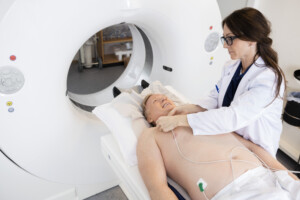
There are two kinds of cancer that radioactivity most commonly causes, especially in children and young adults.
A CAT scan emits more radiation than any other imaging modality.
Younger people are particularly vulnerable to the risk of cancer from a CT scan, but this doesn’t mean that older patients also don’t have an increased risk.
Brain Tumor and Leukemia
These are the two most common from radioactivity in imaging. Researchers wanted to dig further into this.
• The research team looked at the records of 168,384 Dutch children who received at least one CT scan between 1979 and 2012.
• A dose-responsive relationship was found for 1) malignant brain tumors, 2) benign brain tumors, and 3) all brain tumors combined.
• For this particular study, the researchers did not find a link between CT scans and leukemia.
Radiation doses to the bone marrow are low, which may explain this.
Hauptmann et al points out that in some cases, CT scans are used to identify conditions that are associated with a higher risk of tumor development.
Thus, it’s possible that – for some patients — what appears to be a dose-response relationship with CT scans and brain tumors is simply a reflection of the patient’s inherent higher risk of the cancer.
“Epidemiological studies of cancer risks from low doses of medical radiation are challenging,” says lead study author Michael Hauptmann in Journal of the National Cancer Institute (July 2018).
“Nevertheless, our careful evaluation of the data and evidence from other studies indicate that CT-related radiation exposure increases brain tumor risk,” continues the statement.
“Careful justification of pediatric CT scans and dose optimization, as done in many hospitals, are essential to minimize risks.”









































